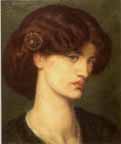 Rossetti's painting Beatrice, A Portrait of Jane Morris portrays Jane Morris, a woman with whom Dante fell in love after the death of his wife, Elizabeth Siddal. Dated 1879, the piece reflects Jane Morris's great beauty and poise. Her voluminous brown hair, tucked back and adorned with a circular, jewel-studded pin, contrasts her finely detailed facial features - her greenish-blue eyes, full lips, long neck, and accentuated jaw-line. Rossetti unites the composition with a green color scheme, used for Jane Morris's eyes, for her dark garment, and for the painting's grayish-green back-drop. Rather than addressing viewers directly with her gaze, Jane Morris looks casually to the right, as if observing some unseen occurrence. although she tilts her head slightly to the right and downward, her regally elongated neck gives the illusion of an upright, dignified posture.
Rossetti's painting Beatrice, A Portrait of Jane Morris portrays Jane Morris, a woman with whom Dante fell in love after the death of his wife, Elizabeth Siddal. Dated 1879, the piece reflects Jane Morris's great beauty and poise. Her voluminous brown hair, tucked back and adorned with a circular, jewel-studded pin, contrasts her finely detailed facial features - her greenish-blue eyes, full lips, long neck, and accentuated jaw-line. Rossetti unites the composition with a green color scheme, used for Jane Morris's eyes, for her dark garment, and for the painting's grayish-green back-drop. Rather than addressing viewers directly with her gaze, Jane Morris looks casually to the right, as if observing some unseen occurrence. although she tilts her head slightly to the right and downward, her regally elongated neck gives the illusion of an upright, dignified posture.
Rossetti, a great admirer of the Italian poet and philosopher Dante Alighieri, based his studies of Jane Morris on Beatrice, Dante's lover from his autobiographical book Vita Nuova. After translating and publishing his rendition of Dante's Vita Nuova in 1861, Rossetti became fascinated by the poet's descriptions of La Donna della Finestra, or the Woman at the Window. The vision of the woman appears to Dante in the midst of his grieving for his lost love, Beatrice. Having both lost dear loves, Dante and Rossetti possess similar distraught emotional states; however, whereas Dante intended the Woman at the Window as more of an allegorical symbol of Philosophy, Rossetti preferred to consider her a real woman. For Rossetti, Jane Morris represented a literal comforting presence in the wake of his wife's tragic death.
Questions
1. Rossetti's choice of models changed the Victorian notion of ideal beauty to the, "tall, thin, long-necked, long-haired stunners of frail health." (Glenn Everett) Consider John Everett Millais's Portrait of a Girl (Sophie Gray), dated 1857; did Millais and Rossetti possess the same notions of female beauty? What similarities and/or differences can you find between the two portraits?
![]()
2. Both Dante and Rossetti have associated the Lady at the Window, or the vision of Beatrice, with the notion of pity. Dante remarked on her, "gaze full of pity," while Rossetti interpreted her human and mental attributes, saying, "Humanly she is the Lady at the Window; mentally, she is the Lady of Pity." Is there anything in Rossetti's depiction of Jane Morris as Beatrice that implies a sense of pity?
3. Rossetti rendered the background of this portrait of Jane Morris with a quite limited color scheme, using primarily muted shades of green, brown, and grey. Why do you think that he chose these shades? Would Jane Morris appear any more beautiful or regal with an elaborate, colored dress?
4. Considering Jane Morris's plain dress and the muted background of the portrait, what is the purpose of the decorative pin in her hair?
Last modified 27 June 2020